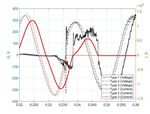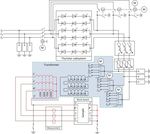Experimental investigation of interrupting capacity of low voltage circuit breaker - IOPscience
←
→
Page content transcription
If your browser does not render page correctly, please read the page content below
Journal of Physics: Conference Series
PAPER • OPEN ACCESS
Experimental investigation of interrupting capacity of low voltage circuit
breaker
To cite this article: A Kvashnin et al 2021 J. Phys.: Conf. Ser. 1753 012020
View the article online for updates and enhancements.
This content was downloaded from IP address 46.4.80.155 on 21/05/2021 at 14:05IPDME 2020 IOP Publishing
Journal of Physics: Conference Series 1753 (2021) 012020 doi:10.1088/1742-6596/1753/1/012020
Experimental investigation of interrupting capacity of low
voltage circuit breaker
A Kvashnin, Iu Murashov and V Frolov
Peter the Great St. Petersburg Polytechnic University, 29, Polytekhnicheskaya, St.
Petersburg, 195251, Russia
E-mail: kvashnin.andrew@gmail.com
Abstract. The experimental results of the circuit breaker interrupting capacity are presented in
the article. The scheme of the experimental workbench and diagnostic methods are described.
The study was performed using high-speed shooting methods. The high-speed shooting results
and diagrams for different modes are presented. The analysis of the arc divider geometry
influence on the extinguishing process for different modes and power factor is completed. A
parametric study of the influence of the power factor, the interrupting current magnitude and
the moment of switching on the extinction of the electric arc in the circuit breaker is also
performed. The influence of the arc chute geometry on the formation of a new arc attachment
point is shown in the article. The test was carried out on the basis of a specially developed
prototype of a low-voltage circuit breaker (AC). The obtained results can be used when
designing a low-voltage circuit breaker (AC).
1. Introduction
An initial analysis of the power system energy security leads to the identification of two main types of
protective devices: circuit breakers and fuses. Unlike fuses, which must be replaced after each
operation, circuit breakers have the ability to re-enable, which makes these devices a more attractive
option. The protective functions of the circuit breaker are aimed at preventing damage to the electrical
circuit from overload currents or short circuits [1-3].
Due to the importance of low-voltage circuit breakers in the power system, the question of the
design method of contact and current-carrying systems, as well as an arc suppression system, is one of
the most pressing issues in the field of development of electrical devices.
The basis of modern technical solutions was laid by the Russian electrical engineer, physicist, and
constructor Mikhail Osipovich Dolivo-Dobrovolsky (1862-1919) back in 1912, which is confirmed by
patents No. 266745 and No. 272742 [4]. Two main types of designs of the arcing chamber of a circuit
breaker have found application in practice (see Figure 1).
All other things being equal, the circuit in Figure 1a allows you to get a shorter arc burning time
than the circuit in Figure 1b, however, the second version of the arcing system provides uniform arc
entry into all gaps between the plates. The second type of the arc suppression system design is used in
the vast majority of modern low-voltage circuit breakers [5-8].
Content from this work may be used under the terms of the Creative Commons Attribution 3.0 licence. Any further distribution
of this work must maintain attribution to the author(s) and the title of the work, journal citation and DOI.
Published under licence by IOP Publishing Ltd 1IPDME 2020 IOP Publishing
Journal of Physics: Conference Series 1753 (2021) 012020 doi:10.1088/1742-6596/1753/1/012020
Figure 1. Types of magnetic blast systems design.
A prototype of a low-voltage circuit breaker was developed with various arc divider geometries (see
Figure 2) in order to study the influence of the arc divider design on the breaking capacity.
Figure 2. Designs of investigated arc chutes
2. Experimental facility
A schematic diagram for the study of the circuit breaker interrupting capacity is shown in Figure 3.
Automatic shutdown is synchronized with high-speed shooting. The current was measured using the
Rogowski coil [9]. The circuit breaker was connected on a test bench (see Figure 3) between the phase
and neutral wires to realize a single-phase short circuit. The activation of the circuit breaker is
implemented using a pneumatic actuator. The control of the pneumatic actuator is synchronized with
the network for the possibility of switching at different points in time relative to the beginning of the
sinusoidal voltage period. The blocks of inductance and resistance allow you to adjust the power factor
and the value of the switched current [10-11]. The prototype of the low-voltage circuit breaker is
designed with specialized viewing windows for high-speed shooting (see Figure 4).
Figure 3. Schematic diagram of the experimental installation
2IPDME 2020 IOP Publishing
Journal of Physics: Conference Series 1753 (2021) 012020 doi:10.1088/1742-6596/1753/1/012020
Figure 4. Windows for high-speed shooting
3. Results and Discussion
Experimental studies were performed for three types of arc divider design with short-circuit current
values of 4kA, 10kA, 16kA, 19kA and 26kA, in addition, an investigation was made of the arc
quenching process dependence on the switching moment with a delay of 3ms, 5ms and 7ms from the
beginning of the sinusoidal short-circuit current period.
The time dependencies for the three types of the arc divider designs for the moment of switching at
5ms and short-circuit current value of 10kA are shown in Figure 5.
Figure 5. The results of experimental studies at Ishc = 10kA and t = 5ms.
3IPDME 2020 IOP Publishing
Journal of Physics: Conference Series 1753 (2021) 012020 doi:10.1088/1742-6596/1753/1/012020
Frames with the high-speed camera, synchronized with current and voltage waveforms, for the
experiment with short-circuit current value of 19kA are shown in Figures 6-10 (current scale:
100kA/V; voltage scale: 1.1kV/V; time scale: 30000 frames per second).
Figure 6. The results of experimental studies at Ishc = 19kA and tstart = 5ms for chutes type 1
(frame 4617)
Figure 7. The results of experimental studies at Ishc = 19kA and tstart = 5ms for chutes type 1
(frame 4686)
Figure 8. The results of experimental studies at Ishc = 19kA and tstart = 5ms for chutes type 1
4IPDME 2020 IOP Publishing
Journal of Physics: Conference Series 1753 (2021) 012020 doi:10.1088/1742-6596/1753/1/012020
(frame 4688)
Figure 9. The results of experimental studies at Ishc = 19kA and tstart = 5ms for chutes type 1
(frame 4734)
Figure 10. The results of experimental studies at Ishc = 19kA and tstart = 5ms for chutes type 1
(frame 4738)
Figure 11. The results of experimental studies at Ishc = 19kA and tstart = 5ms for chutes type 1
(frame 4785)
5IPDME 2020 IOP Publishing
Journal of Physics: Conference Series 1753 (2021) 012020 doi:10.1088/1742-6596/1753/1/012020
The initial state is shown in Figure 6. You can see the formation of a new arc attachment point and
arc shunting proccess from Figure 7 to Figure 8 and from Figure 9 to Figure 10. The end of the arc
extinguishing process is shown in Figure 11.
4. Conclusion
An experimental study of the interrupting capacity of the low-voltage circuit breaker has been
performed. The study was performed using high-speed shooting methods. The analysis of the arc
divider design influences the arc extinguishing process. A parametric study of the power factor
influence, the magnitude of the switched current influence and the moment of switching influence on
the extinction of the electric arc in the arc quenching system of the circuit breaker was also performed.
As a result of experimental studies, it was found that the third type of the arc divider (see Figure 2)
does not extinguish at short-circuit currents of 10 kA and higher. At small values of the short-circuit
current (up to 19 kA), the arc quenching process more efficiently occurred when using the second type
of the arc divider (see Figure2), the value of the released heat power during arcing in the case of the
second type of arc divider is much smaller than that of the first type.
Interrupting capacity of the circuit breaker is significantly reduced with a decrease in the power
factor value. Interrupting capacity of the circuit breaker decreases with an increase in the switching
delay time, while switching the circuit breaker in the second half of the half-cycle of a sinusoidal
short-circuit current, there is no extinguishing in the first current zero.
References
[1] Skamyin A N and Dobush V S 2018 Analysis of nonlinear load influence on operation of
compensating devices IOP Conference Series: Earth and Environmental Science 194 (5) DOI:
10.1088/1755-1315/194/5/052023
[2] Koptev V Y, Kopteva A V and Starshaya V V 2020 Information Support for the Process of
Multiphase Flows Transportation Based on the Introduction of a Radioisotope Non-Separation
Hydrocarbon Measuring System IEEE Conference of Russian Young Researchers in Electrical and
Electronic Engineering (EIConRus) 674-679 DOI: 10.1109/EIConRus49466.2020.9039314
[3] Voytyuk I N, Zamyatina E N and Zamyatin E O 2019 Increasing the energy efficiency of an
enterprise by point compensating of power quality distortions Proceedings of the International
Scientific Conference on Energy, Environmental and Construction Engineering (EECE-2019)
[4] Bron O B, Dolivo-Dobrovolsky M O 1949 Inventor of spark arrester Electricity 9 71-73
[5] Chunping N, Juwen D, Yi W, Fei Y, Delong D, Xingyu F and Mingzhe R 2016 Simulation and
experimental analysis of arc motion characteristics in air circuit breaker Plasma Science and
Technology 18 (3) 241 DOI: 10.1088/1009-0630/18/3/05
[6] Karetta F and Lindmayer M 1996 Simulation of the gasdynamic and electromagnetic processes
in low voltage switching arcs Proceedings of the 42nd IEEE Holm Conference
[7] Igumnov N P 2009 Typical elements and devices of automatic control systems: Textbook for
students of the specialty 220301. - 3rd ed. KPK
[8] Ustinov D A 2019 Increase of dynamic stability of alternating current electric drives at short-
term violations of oilfield power supply 12th International Scientific and Technical Conference
Dynamics of Systems, Mechanisms and Machines DOI: 10.1109/Dynamics.2018.8601457
[9] Turysheva A V and Baburin S V 2016 Justification of power supply system’s structure of oil
and gas facilities using backup energy sources with associated petroleum gas as the energy carrier
International Journal of Applied Engineering Research 11 (1) 749-755
[10] Chmilenko F V and Rastvorova I I 2018 Improvement of quality of aluminum ingots at
electromagnetic processing Journal of Physics: Conference Series 1118(1) 012030
[11] Kozjaruk A E, Vasilev B U, Shtop S A and Serdukov N A 2018 Currents in bearings of
induction motors of electric drives with semiconductor converter 17th International Ural Conference
on AC Electric Drives pp 1-5 DOI: 10.1109/ACED.2018.8341707
6You can also read



























































